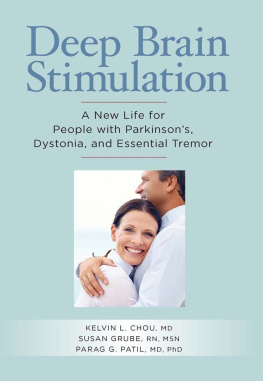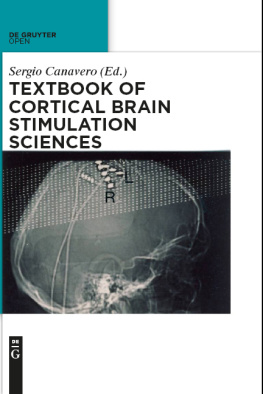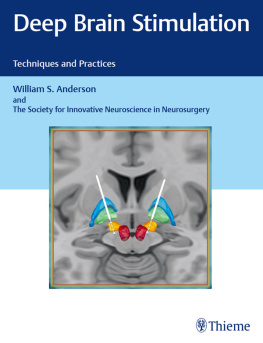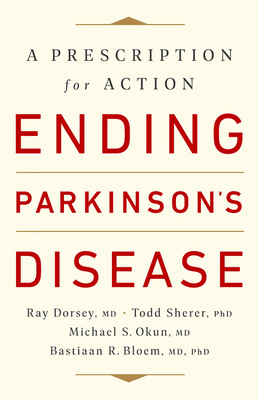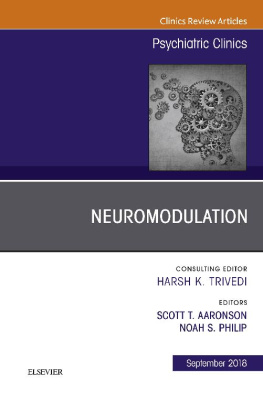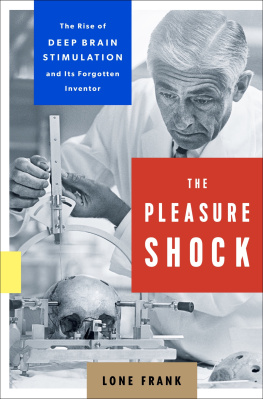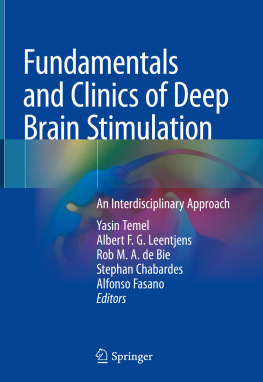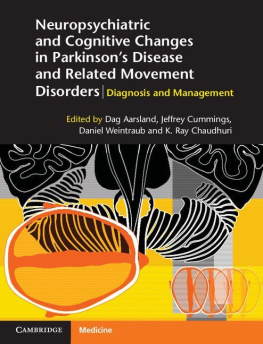Deep Brain Stimulation
A New Life for People with Parkinsons, Dystonia, and Essential Tremor
Kelvin L. Chou, MD
Susan Grube, RN, MSN
Parag G. Patil, MD, PhD
Visit our website at www.demoshealth.com
ISBN: 978-1-936303-11-3
e-book ISBN: 978-1-617050-63-3
Acquisitions Editor: Noreen Henson
Compositor: Manila Typesetting Company
2012 by Demos Medical Publishing, LLC. All rights reserved. This book is protected by copyright. No part of it may be reproduced, stored in a retrieval system, or transmitted in any form or by any means, electronic, mechanical, photocopying, recording, or otherwise, without the prior written permission of the publisher.
Medical information provided by Demos Health, in the absence of a visit with a health care professional, must be considered as an educational service only. This book is not designed to replace a physician's independent judgment about the appropriateness or risks of a procedure of therapy for a given patient. Our purpose is to provide you with information that will help you make your own health care decisions.
The information and opinions provided here are believed to be accurate and sound, based on the best judgment available to the authors, editors, and publisher, but readers who fail to consult appropriate health authorities assume the risk of injuries. The publisher is not responsible for errors or omissions. The editors and publisher welcome any reader to report to the publisher any discrepancies or inaccuracies noticed.
Library of Congress Cataloging-in-Publication Data
Chou, Kelvin L.
Deep brain stimulation : a new life for people with Parkinson's, dystonia and essential tremor / Kelvin L. Chou, Susan Grube, Parag G. Patil.
p. cm.
Includes bibliographical references and index.
ISBN 978-1-936303-11-3 (pbk.)
1. Brain stimulation. 2. Movement disorders--Treatment. I. Grube, Susan. II. Patil, Parag G. III. Title.
RC350.B72C48 2012
616.8--dc23
2011039580
Special discounts on bulk quantities of Demos Health books are available to corporations, professional associations, pharmaceutical companies, health care organizations, and other qualifying groups. For details, please contact:
Special Sales Department
Demos Medical Publishing, LLC
11 West 42nd Street, 15th Floor
New York, NY 10036
Phone: 800-532-8663 or 212-683-0072
Fax: 212-941-7842
E-mail:
Printed in the United States of America by Bang Printing.
11 12 13 14 / 5 4 3 2 1
Foreword
If youre thinking about having DBS for a neurological problem, read this book. It explains exactly how the process of selecting patients is made, what steps are necessary before surgery, what happens during surgery, and what happens after surgery. Each step of the lengthy process is discussed in detail. Pictures and photos illustrate much of the process. Time estimates are even provided so you will understand why the surgery takes so long; what placement of the frame means; and what to expect on completing the surgery. These authors discuss financial aspects of the surgery and how the results of surgery may affect the family and social support system. It is an all-inclusive discussion that should help quell anxieties while youre waiting or deciding. There is a glossary to help you understand any technical terms you are bound to come across on the internet or in any discussion.
DBS is, at least for most of us, still something of a science fiction type approach to treating an illness although its been an FDA approved treatment for many years, paid for by all medical insurers. These authors are, however, very much grounded in reality. They have lots of experience and have been through thick and thin with many, many patients (including my own), experiencing the wonderful joy of the great successes but theyve also been there for the patients with the side effects or the disappointing responses. While there is little so rewarding for a health professional as when a patient describes the surgery as my second birthday, there is also little so disappointing as a treatment failure.
These authors present an accurate and balanced picture of DBS and make it clear that it always represents the choice made by weighing the risks and potential side effects. This is not curative surgery. It is one treatment approach, like a medication. Where the balance point is located for making the decision differs for each individual, as this book makes very clear.
A frequent radio advertisement for a clothing store notes that, An educated consumer is our best customer. That certainly applies to DBS surgery. Take the time to learn all you can. This book will help.
Joseph H. Friedman, MD
Director, Movement Disorders Program
Butler Hospital
Department of Neurology
Alpert Medical School of Brown University
Providence, Rhode Island
ONE
A Little History on Deep Brain Stimulation
DEEP BRAIN STIMULATION THERAPY
A deep brain stimulator (DBS) device is similar to a pacemaker for the heart, but instead of having electrodes (or electrical wires) implanted in the heart, the electrodes are placed into the brain. The electrodes carry electrical signals to specific brain locations. These electrical signals, like a heart pacemaker, cause the brain cells around the DBS electrode to change their activity. By changing the activity of brain cells, DBS can help the symptoms of many neurological disorders, depending on where the electrodes are placed.
Diseases treated with DBS include Parkinsons disease, essential tremor (ET), dystonia, and a few other neurological and psychiatric disorders. Parkinsons disease, essential tremor, and dystonia are examples of movement disorders. Movement disorders are neurological diseases that affect the ability to produce and control movements of the body. In individuals with these conditions, the firing patterns of nerve cells within certain parts of the brain become abnormal. These abnormal patterns spread through the electrical circuits of the brain to other areas such as the brain areas connected to the spinal cord that guide movement, the brain areas that steady the limbs and smooth movement, or the brain areas that help to start and stop movements. The abnormal activity in these brain circuits creates the symptoms of the disease condition, such as tremor in Parkinsons disease and essential tremor or the abnormal muscle contractions in dystonia.
UNDERSTANDING THE MOTOR SYSTEM OF THE BRAIN
The way we move requires a lot of processes to occur in the brain in a coordinated way. Today, we know that there are two systems (or types of circuits) in the brain that control movement.
The pyramidal system is one of these motor circuits. It is composed of cells that directly control the motor neurons (or nerve cells) of the spinal cord. The principal area of the brain containing these cells is the primary motor cortex, which is located on the surface of the brain, just above the ear. Cells in this region extend portions of themselves (known as processes) down through a bundle of nerves called the internal capsule, through the brainstem (the connection between the brain and the spinal cord), and eventually to the spinal cord. The pyramidal system itself is named after the pyramid shape of these processes in the brainstem.
The extrapyramidal system is the second motor system of the brain. It is composed of the circuits of the brain whose fibers do not travel through the pyramids. The extrapyramidal circuits shape movement by influencing our reflexes, coordination, and posture. These circuits also break down our complex movements into sequences of simple ones.
The pyramidal system is largely located in the surface portion of the brain: the cerebral cortex. The extrapyramidal system is located deep within the brain, in structures such as the basal ganglia, brainstem, and cerebellum.

